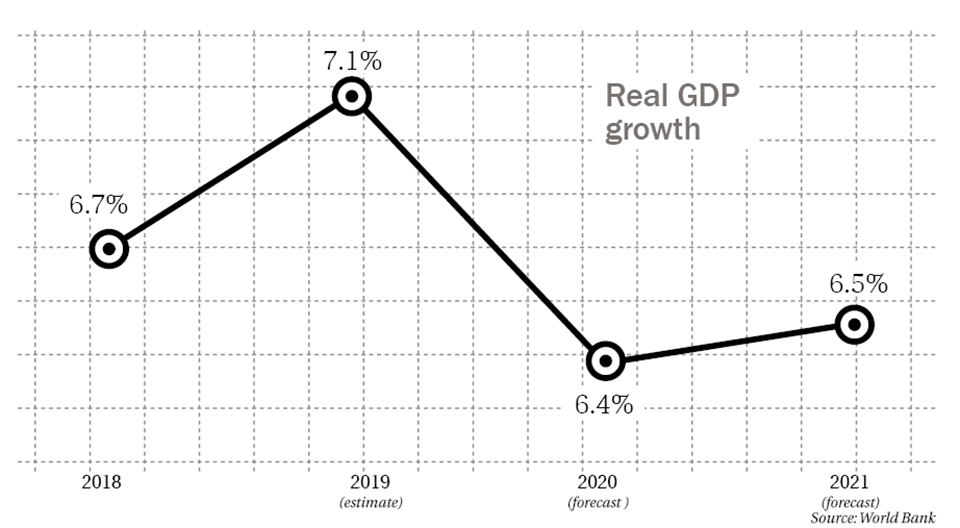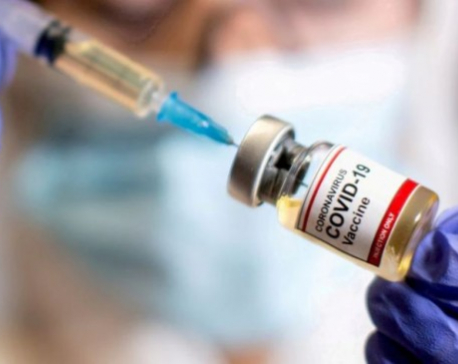
OR
World Bank projects Nepal’s GDP growth rate to average at 6.5%
Published On: October 14, 2019 10:29 AM NPT By: Republica | @RepublicaNepal

KATHMANDU, Oct 14: The World Bank has projected the growth of Nepal’s gross domestic product (GDP) to average at 6.5% over the current fiscal year – FY2019/20 and the next fiscal year – FY2020/21.
The bank made the projection in the latest edition of South Asia Economic Focus, Making (De)centralization Work, a twice-a-year regional economic update released Sunday.
The medium-term outlook is supported by government consumption and investment, according to the bank. Reasoning strong services and construction activity due to rising tourist arrivals and higher public spending, the international financial institution made the growth projection for Nepal.
On the regional front, South Asia is projected to slow to 5.9% in 2019, down 1.1 percentage points from April 2019 estimates in line with a global downward trend, casting uncertainty about a rebound in the short term, according to the bank.
“Declining industrial production and imports, as well as tensions in the financial markets reveal a sharp economic slowdown in South Asia,” a statement issued by the World Bank on Sunday quoted Vice President for the South Asia Region Hartwig Schafer as saying.
Nepal holds the second highest position among South Asian countries with an estimated 7.1% GDP growth rate in the FY 2019/20. Bangladesh tops the list with an estimated 8.1% GDP growth rate for the current fiscal year.
Driven by private investment and consumption, the growth rate in the current fiscal year is estimated to have increased to 7.1%, marking three consecutive years of over 6% growth.
However, the World Bank’s projection is still lower than the government’s target to attain 8.5% growth rate in the current fiscal year. The macro poverty outlook indicator shows that the GDP growth at constant market prices for the year 2019 is estimated to be 7.1%, and forecast 6.4% for 2020 and 6.5% for 2021.
According to the report, growth on the supply side will be driven by services, underpinned by steady remittance inflows and high tourist arrivals whereas investment and government consumption are expected to be the main drivers of growth on the demand side. The tourist arrivals will be supported by the Visit Nepal 2020 campaign, the completion of the second international airport and the construction of big hotels in the country.
The report states that the public consumption will be supported by increased spending on salary and goods and services. In addition, efforts aimed at building capacity at the sub-national levels and the implementation of performance-based contracts at the central level will also result in higher overall public spending.
“The implementation of the 2019 national work plan to minimize the trade deficit along with investment related initiatives such as establishing a one-stop service center is expected to support private investment,” read the report.
However, increased import tariffs on selected agricultural products and consumer goods are expected to lower the growth of private consumption.
Inflation is expected to increase to 4.5% in the current fiscal year up from 4.2% in the last fiscal year with higher public sector wages, increases in import duties on agricultural and industrial goods, and the removal of value-added-tax exemptions on some intermediate goods and services, the report states. On the contrary, the regular supply of electricity at low cost and low inflation in India will offset some of the increase.
According to the report, remittance as a share of GDP is expected to stabilize at 25% over the medium term and the government spending is expected to increase to 29.7% of GDP by FY2021/22 due to salary increases, higher social security spending, and a pick-up in capital investments.
You May Like This

World Bank says will boost COVID-19 vaccine funding to $20 bln
WASHINGTON, June 30: The World Bank on Wednesday pledged to boost available funding for COVID-19 vaccine purchases and deployment to... Read More...

World Bank's recommendation on fewer banks 'lacks logic'
KATHMANDU, Sept 17: A recent World Bank report recommended that the government further consolidate the banking sector and lower the number... Read More...

WB to provide Rs 23.5 billion for financial, energy sectors
KATHMANDU, Oct 11: The Ministry of Finance and the World Bank have signed two agreements totaling $200 million, nearly Rs 23.5... Read More...










Just In
- Heavy rainfall likely in Bagmati and Sudurpaschim provinces
- Bangladesh protest leaders taken from hospital by police
- Challenges Confronting the New Coalition
- NRB introduces cautiously flexible measures to address ongoing slowdown in various economic sectors
- Forced Covid-19 cremations: is it too late for redemption?
- NRB to provide collateral-free loans to foreign employment seekers
- NEB to publish Grade 12 results next week
- Body handover begins; Relatives remain dissatisfied with insurance, compensation amount







Leave A Comment